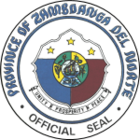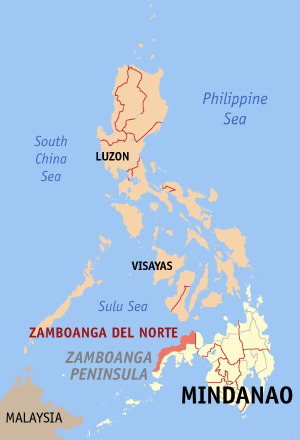Zamboanga del Norte
| Province of Zamboanga del Norte | |
 Provincial seal of Zamboanga del Norte |
|
 Map of the Philippines with Zamboanga del Norte highlighted |
|
| Region | Zamboanga Peninsula (Region IX) |
| Capital | Dipolog City |
| Divisions | |
| - Highly urbanized cities | 0 |
| - Component cities | 2 |
| - Municipalities | 25 |
| - Barangays | 691 |
| - Congressional districts | 3 |
| Population | 27th largest |
| - Total (2007) | 823,130 |
| - Density | 124 /km² (321 /sq mi) (27th highest) |
| Area | 8th largest |
| - Total | 6,618.0 km2 (2,555 sq mi) |
| Founded | June 23, 1635 and June 6, 1952 |
| Spoken languages | Cebuano, Chavacano, Subanon, Tagalog English |
| Governor | Rolando E. Yebes |
Zamboanga del Norte is a province of the Philippines located in the Zamboanga Peninsula region in Mindanao. Its capital is Dipolog City and the province borders Zamboanga del Sur and Zamboanga Sibugay to the south and Misamis Occidental to the east. The Sulu Sea lies to the northwest of Zamboanga del Norte.
Contents |
Demographics
Zamboanga del Norte has a population of 823,130 according to the 2000 census. Its population density is 124/km². It is ranked 27th among the provinces both in terms of population and population density.
The main dialect spoken is Cebuano. Chavacano, English and Tagalog are also spoken, indicative of a high level of literacy. The original and native Subanon dialect lives on, especially in the highlands.
Economy
About half of the province's land area is devoted to agriculture. Corn, coconut, and rice are major crops. The province being rich in marine and mineral sources, its fish production has accelerated through the development of fishponds. Commercial fishing has likewise steadily increased through the years, with the yellow fin tuna as the primary species.
In 2006, a study by National Statistics Coordination Board (NSCB), found Zamboanga del Norte Province to be the Philippines's poorest with a poverty incidence rate of 64.6% in 2003, an increase from 47% in year 2000 statistical figures. [1]
Geography
Political
Zamboanga del Norte is subdivided into 25 municipalities and 2 cities. These are further subdivided into 691 barangays, and clustered into 3 congressional districts.
Cities
- Dapitan City
- Dipolog City
Municipalities
|
|
Physical
Zamboanga del Norte comprises the northern portion of the Zamboanga Peninsula. It is bounded on the north and west by the Sulu Sea, on the east by Misamis Occidental, and on the south by Zamboanga del Sur.
The province occupies a total land area of 6,618 square kilometers. It has an average elevation of 243.8 meters, with Mt. Dabiak in Katipunan as the highest peak at 2,600 meters. Other parts, near the coastlines, are plains. The province's irregular coastline runs 400 kilometers from north to south.
Zamboanga del Norte has a mild and moderate climate due to evenly distributed rainfall throughout the year. Its southern portion has a longer dry season.
History
The early history of Zamboanga del Norte is shared with that of Zamboanga City, which had been the center of the entire Mindanao area, most notably during the American era. When Zamboanga City became a chartered city on October 12, 1936, it encompassed the southern tip of the Zamboanga Peninsula and the island of Basilan, making it the largest city in the world in terms of land area.
This all changed in 1948 when Basilan was made into a separate Chartered City, and further, when Republic Act No. 711, issued on June 6, 1952, created two more provinces out of Zamboanga City. One of these provinces was Zamboanga del Norte.
External links
- The Official Website of the Provincial Government of Zamboanga del Norte
- WOW Philippines - Zamboanga del Norte
- Daily Zamboanga Times
- Zamboanga Peninsula News
- The Official Website of Zamboanga Today Newspaper
References
|
||||||||